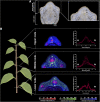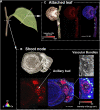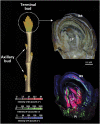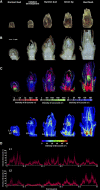Seasonal Zinc Storage and a Strategy for Its Use in Buds of Fruit Trees
- PMID: 32423902
- PMCID: PMC7333724
- DOI: 10.1104/pp.19.01563
Seasonal Zinc Storage and a Strategy for Its Use in Buds of Fruit Trees
Abstract
Bud dormancy allows deciduous perennial plants to rapidly grow following seasonal cold conditions. Although many studies have examined the hormonal regulation of bud growth, the role of nutrients remains unclear. Insufficient accumulation of the key micronutrient zinc (Zn) in dormant buds affects the vegetative and reproductive growth of perennial plants during the subsequent year, requiring the application of Zn fertilizers in orchard management to avoid growth defects in fruit trees. However, the mechanisms of seasonal Zn homeostasis in perennial plants remain poorly understood. Here, we provide new insights into Zn distribution and speciation within reproductive and vegetative buds of apple (Malus domestica) and four other deciduous fruit trees (peach [Amygdalus persica], grape [Vitis vinifera], pistachio [Pistacia vera], and blueberry [Vaccinium spp.]) using microscopic and spectroscopic characterization techniques comprising synchrotron-based x-ray fluorescence and x-ray absorption near-edge-structure analyses. By establishing a link between bud development and Zn distribution, we identified the following important steps of Zn storage and use in deciduous plants: Zn is preferentially deposited in the stem nodes subtending apical and axillary buds; Zn may then be sequestered as Zn-phytate prior to dormancy; in spring, Zn effectively releases for use during budbreak and subsequent meristematic growth. The mechanisms of Zn homeostasis during the seasonal cycles of plant growth and dormancy described here will contribute to improving orchard management, and to selection and breeding of deciduous perennial species.
© 2020 American Society of Plant Biologists. All Rights Reserved.
Figures









Similar articles
-
Spatial imaging reveals the pathways of Zn transport and accumulation during reproductive growth stage in almond plants.Plant Cell Environ. 2021 Jun;44(6):1858-1868. doi: 10.1111/pce.14037. Epub 2021 Apr 14. Plant Cell Environ. 2021. PMID: 33665861
-
Overexpression of Prunus DAM6 inhibits growth, represses bud break competency of dormant buds and delays bud outgrowth in apple plants.PLoS One. 2019 Apr 9;14(4):e0214788. doi: 10.1371/journal.pone.0214788. eCollection 2019. PLoS One. 2019. PMID: 30964897 Free PMC article.
-
Efficient phloem remobilization of Zn protects apple trees during the early stages of Zn deficiency.Plant Cell Environ. 2019 Dec;42(12):3167-3181. doi: 10.1111/pce.13621. Epub 2019 Aug 13. Plant Cell Environ. 2019. PMID: 31325325
-
Seasonal nitrogen cycling in temperate trees: Transport and regulatory mechanisms are key missing links.Plant Sci. 2018 May;270:268-277. doi: 10.1016/j.plantsci.2018.02.021. Epub 2018 Mar 1. Plant Sci. 2018. PMID: 29576080 Review.
-
Regulatory Mechanisms of Bud Dormancy: Environmental, Hormonal, and Genetic Perspectives.Int J Mol Sci. 2025 Mar 11;26(6):2517. doi: 10.3390/ijms26062517. Int J Mol Sci. 2025. PMID: 40141161 Free PMC article. Review.
Cited by
-
Towards routine 3D characterization of intact mesoscale samples by multi-scale and multimodal scanning X-ray tomography.Sci Rep. 2022 Oct 8;12(1):16924. doi: 10.1038/s41598-022-21368-0. Sci Rep. 2022. PMID: 36209291 Free PMC article.
-
Identification of potential pathways associated with indole-3-butyric acid in citrus bud germination via transcriptomic analysis.Funct Integr Genomics. 2021 Nov;21(5-6):619-631. doi: 10.1007/s10142-021-00802-y. Epub 2021 Sep 2. Funct Integr Genomics. 2021. PMID: 34476672
References
-
- Alloway BJ.(2009) Soil factors associated with zinc deficiency in crops and humans. Environ Geochem Health 31: 537–548 - PubMed
-
- Begum MC, Islam M, Sarkar MR, Azad MAS, Huda AKMN, Kabir AH(2016) Auxin signaling is closely associated with Zn-efficiency in rice (Oryza sativa L.). J Plant Interact 11: 124–129
-
- Brinch-Pedersen H, Sørensen LD, Holm PB(2002) Engineering crop plants: Getting a handle on phosphate. Trends Plant Sci 7: 118–125 - PubMed
-
- Broadley MR, White PJ, Hammond JP, Zelko I, Lux A(2007) Zinc in plants. New Phytol 173: 677–702 - PubMed
Publication types
MeSH terms
Substances
Grants and funding
LinkOut - more resources
Full Text Sources
Miscellaneous

